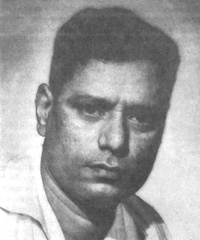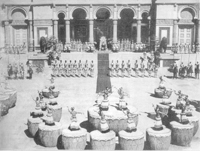|
Chandralekha is one of the finest celluloid entertainers ever produced in India. Film critic V.A.K. Ranga Rao describes the film as "the most complete entertainer ever made." Made in Tamil and, later, in Hindi, Chandralekha was one of the biggest grossers in Indian cinema history. Shorter versions of the film in English were screened in the U.S.A., Japan and the Scandinavian countries in the 1950s.
|
Sixty years ago the biggest box office hit of Tamil cinema was released. When made by the same studio in Hindi, it was so great a success that it opened up the theatres of the North to films made in the South. This is the story of the making of that film, Chandralekha, recalled by Randor Guy. |
With the smashing success of Chandralekha, S.S. Vasan became a national figure, but in his simple garb (he always wore a dhoti, shirt and slippers like the average South Indian in the street), he did not look like a movieman at all. Yet he was to become one of the finest directors in Indian cinema. His feel for a good tale, his passion for editing and his untiring industry were the keys to his success as a director.
He turned to Chandralekha after two of his films, Mangamma Sabatham (1943) and the Telugu Balanagamma (1942), both based on popular folklore, turned out to be superhits, netting profits of Rs. 4 million, a staggering sum in the 1940s.

S.S. Vasan

The famous drum dance scene. (Courtesy: Film news Anandan.) |
He wanted to produce a colossal celluloid extravaganza a la Cecil B. DeMille and asked his story department to come up with a screenplay. Gemini writers, like Kothamangalam Subbu, Ki. Ra. Sangu Subramaniam, Veppathur Kittoo and others, saw Mangamma Sabatham and Balanagamma as heroine-oriented stories and, not surprisingly, looked for another such tale to narrate to Vasan.
When they told him the story of a tough, talented woman – she is so smart, she outwits a vicious bandit, delivers the final insult by slashing off his nose and, as a finishing touch, fills the bloodied gaping hole with hot, red chilli powder! – he thought it too gruesome, crude, even vulgar. But when he threw it out, one thing stuck in his mind: the name of the woman, Chandralekha.
He immediately announced his next film as Chandralekha, publicising it with front-page advertisements in all the leading publications. Yet, at the time, Vasan had the title but nothing else.
The frantic search for a story now began. Three months later there was no story in sight. Vasan began to get impatient. One day, he told the writers he was shelving the project and would concentrate on making Avvaiyyar, another dream of his. Veppathur Kittoo, however, pleaded for one last chance and got a week's time.
Kittoo, who was director T.G. Raghavachari's (aka Acharya) assistant and favourite disciple, used to call on his guru at his home every morning. That lucky morning, he saw a book on TGR's desk, a novel called Robert McCaire the Male Bandit by G.W.M. Reynolds (of the Mysteries of the Court of London fame). Kittoo began to flip through it and read...
"...it's night in rural England and a mail coach convoy trots its way, when, suddenly, Robert McCaire, the bandit, and his henchmen on horses emerge from the surrounding darkness, hold up the convoy and rob it. Hiding under a seat is a young woman fleeing from a harsh home. She is a dancer and when she refuses to dance, the bandit whips her into submission..."
Vasan was fascinated when he heard Veppathur Kittoo narrate a story based on this episode and he decided to go ahead with the film. He named the heroine 'Chandralekha' and his enthusiasm was so great that he did not unduly bother about the absence of the rest of the story.
Over five years, from 1943 to 1948, Chandralekha was made, re-made, re-re-made, scrapped, re-shot, scrapped and re-re-shot, with the film ultimately costing over Rs. 3 million. It was the most expensive movie made in India till then.
The script called for two major roles, the two sons of a king, the elder being the good prince, his brother a villainous, amoral person. M.K. Radha, tall, handsome and talented, one of the earliest successful heroes of Tamil cinema, was on Vasan's payroll. (Gemini Studio had a 'stable' of actors.) He would be a good choice as the younger prince, Vasan felt. But M.K. Radha, like most South Indian stars, was worried about his 'image' and did not feel happy about being asked to play the villain. He, however, found it a delicate task telling his boss, so he left the unpleasant task to his wife. His wife, a former actress, succeeded in convincing Vasan, who agreed to cast MKR as the soft prince, whose role was more passive.
The role of the younger brother, Sashankan, now presented problems. Vasan chose K.J. Mahadevan to play the role and Acharya, who was named the director, nodded his tufted head. England-educated KJ (as he was familiarly known) was sophisticated, soft-spoken and cultured. He had played the hero in Thyaga Bhoomi, the first film distributed by Vasan. Some scenes were then shot with KJ as the prince who turns bandit to create chaos and confusion, but the 'rushes' proved disappointing. So, Ranjan (R. Venkataramana Sarma in real life), another college-educated, sophisticated Tamil actor, who had played the father and son in Gemini's Mangamma Sabatham, was chosen and proved an apt foil.
Gemini Studio, right in the heart of the city, thereafter became a veritable hive of film-making activity. Kothamanglam Subbu recalled years later, "During the making (of Chandralekha), our studio looked like a small kingdom...horses, elephants, lions, tigers in one corner, palaces here and there, over there a German lady training nearly a hundred dancers on one studio floor, a shapely Sinhalese lady teaching another group of dancers on real marble steps adjoining a palace, a studio worker making weapons, another making period furniture using expensive rosewood, set props, headgear, and costumes, Ranjan undergoing fencing practice with our fight composer 'Stunt Somu', our music directors composing and rehearsing songs in a building... there were so many activities going on simultaneously round the clock."
Beautiful, buxom, with lovely eyes and sensuous lips, T.R. Rajakumari, a talented actress, dancer and singer, the first 'dream girl' of the Tamil cinema, was cast as Chandralekha. (An early 'house ad' for Chandralekha on the inside cover of the Nandanar song-book printed in September 1942 carried the name of K.L.V. Vasantha as Chandralekha. Why did Vasan give up KLV and choose T.R. Rajakumari? A possible reason was that Vasantha was moving to Modern Theatres, Salem unit, as a permanent artiste. She later became the wife of T.R. Sundaram who owned Modern Theatres.)
There was a minor role, the hero's bodyguard, which, a talented stage-actor, who had been on stage from boyhood and graduated to female roles – he had even grown his hair long for this purpose – coveted. He called on Veppathur Kittoo several times asking for a break, even an also-ran role. Eventually Kittoo took this slim, struggling stage actor to the 'Boss' who had seen him perform on stage. To the astonishment of Kittoo – and the poor actor – Vasan told the aspirant bluntly that he was totally unsuited for films and warned him not to be lured by the honey-coated words of film people and give up the stage. Vasan later told Kittoo that the actor had a squint eye and chided his assistant for wasting his precious time! The actor whom Vasan turned down was Villupuram Chinniah Pillai Ganeshamurthy, later known as Sivaji Ganesan! The rift between the two that began then never quite ended.
TGR began shooting the film and for the next five years. Vasan thought of nothing else. According to Veppathur Kittoo, TGR directed more than half of Chandralekha. Then, Vasan and Acharya had some misunderstanding over the shooting of some sequences at the Governor's Estate (now, Raj Bhavan, Guindy), and Acharya walked out of the film. Vasan took over, making his debut as director.
At one stage, Vasan decided to add a circus as part of the film and the screen story was re-woven accordingly. In her attempts to save her lover imprisoned in a mountain cave, Chandralekha seeks the help of a passing circus company. The famous comedy pair N.S. Krishnan-T.A. Mathuram were roped in as the circus performers who helped the hero to rescue Chandralekha from the clutches of the villain. Later, to repay her debt of gratitude, she joins the circus and works as a trapeze artiste. Kittoo travelled all over South India and Ceylon and he watched over fifty circus companies perform before he found the right unit.
The shooting of the circus scenes was entrusted to K. Ramnoth. A brilliant technician and a camera-wizard, he captured flying trapeze acts high above the ground... wild animals fighting... and a shot that is breathtaking even by today's standards... To quote Kittoo, "In those days, we had no zoom lenses and yet Ramnoth did it. One night, while Chandralekha is performing on the flying trapeze, she notices the villain's henchman in the front row. She is on her perch high up and he is seated in a ringside chair. Shock hits her and to convey the shock the camera zooms fast from her to the man. Today, with a fast zoom shot it can be done very easily, but there was no such lens forty years ago. Ramnoth did it using the crane. He planned it well and rehearsed the shot for long. He took the shot 20 times and selected the best 'take'. It was amazing!"
Then there was artistic and brilliantly choreographed drum dance, the highlight of the film and the first of its kind in Indian cinema.
Chandralekha arranges a spectacular dance in which many dancers, including herself, dance on a number of tall drums, inside which her lover's men are hiding, waiting to come out and fight the villain. Vasan had nearly 400 dancers on monthly salary and they had daily rehearsals for six months; that single sequence cost Vasan Rs. 5 lakh (half a million) in the 1940s, it was said. The man who designed all this was Chief Art Director A.K. Sekhar, whose contribution was palatial splendour. The two music composers, M.D. Parthasarathy and S. Rajeswara Rao, created a fine blend of lilting music of many schools, Carnatic, Hindustani and even Western – waltzes, jazz, etc. – and many of the songs became hits.
To top it all, Vasan came out with a gigantic publicity campaign which made the nation sit up and take notice. His budget was said to have been nearly a million rupees, an incredible sum in those days. Full-page ads,
huge multicoloured posters, glossily printed brochures, press books, expensively printed songbooks, were to be seen everywhere... it was all unheard of in India.
Chandralekha, made in Tamil and Hindi, created a sensation and smashed box-office records all over the country. Its Hindi version opened the doors for South Indian producers to sell their Hindi-wares in the North.
Honours came seeking Vasan, but he took them in his stride. He sat on many committees and panels and bodies connected with the Indian film industry. He was a member of the Rajya Sabha for a term, and served as a director of a leading bank. But it was as S.S. Vasan, South India's 'Cecil B. DeMille', that he will be remembered. (Excerpted from Starlight, Starbright with the permission of the author.)
|